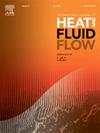Experimental investigation on the fabrication of electroplating masks for silicon heterojunction solar cell grid electrodes via inkjet printing
IF 2.6
3区 工程技术
Q2 ENGINEERING, MECHANICAL
International Journal of Heat and Fluid Flow
Pub Date : 2024-12-27
DOI:10.1016/j.ijheatfluidflow.2024.109729
引用次数: 0
Abstract
Replacing screen-printed silver grids with electroplated copper grid technology enables the large-scale production and application of silicon heterojunction solar cells. The grid electroplating mask is crucial for forming well-defined copper grids with high aspect ratios. This paper introduces a novel process for fabricating grid electroplating masks for silicon heterojunction solar cells using inkjet printing, which indirectly prepares the masks through two rounds of inkjet printing. Initially, hot-melt wax lines are printed to define the grid pattern, wherein the effects of piezoelectric nozzle waveform configurations on inkjet droplet morphology and size, the printing height on droplet stacking patterns, and the printing speed on hot-melt wax line widths are investigated. The results show that reducing the rise, fall, and retention time of the waveform will reduce the droplet volume, the inkjet printing height of 2.2 μm is conducive to the cooling of hot melted wax droplets and obtaining better droplet stacking morphology, and the inkjet printing speed of 50 mm/s is conducive to the obtaining of narrower hot-melt wax lines. Consequently, hot-melt wax lines with an average line width of 22.67 μm and a line height of 18 μm are successfully obtained on the seed layer silicon wafers. Subsequently, mask printing and hot-melt wax line removal are performed, yielding grid electroplating masks with trench widths of 20.254 μm, heights of 12.241 μm, and an aspect ratio reaching 0.6. This approach significantly simplifies the electroplating mask process and is of great significance for achieving copper grids with higher aspect ratios.
求助全文
约1分钟内获得全文
求助全文
来源期刊

International Journal of Heat and Fluid Flow
工程技术-工程:机械
CiteScore
5.00
自引率
7.70%
发文量
131
审稿时长
33 days
期刊介绍:
The International Journal of Heat and Fluid Flow welcomes high-quality original contributions on experimental, computational, and physical aspects of convective heat transfer and fluid dynamics relevant to engineering or the environment, including multiphase and microscale flows.
Papers reporting the application of these disciplines to design and development, with emphasis on new technological fields, are also welcomed. Some of these new fields include microscale electronic and mechanical systems; medical and biological systems; and thermal and flow control in both the internal and external environment.
 求助内容:
求助内容: 应助结果提醒方式:
应助结果提醒方式:


